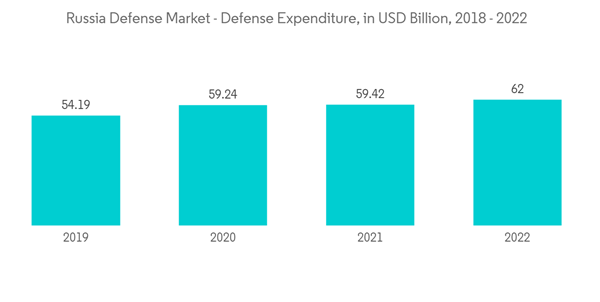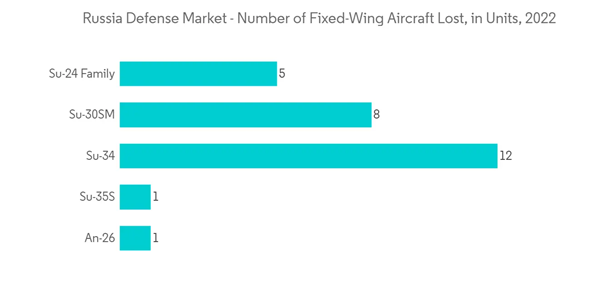The COVID-19 pandemic's impact on the Russian economy was relatively low due to the country's defense spending. Russia is currently engaged in three active wars with neighboring countries: the Russo-Ukrainian War, the Russian military intervention in the Syrian Civil War, and the Central African Republic Civil War. Additionally, economic sanctions hit Russia over its annexation of Crimea from Ukraine and its ongoing invasion of the country.
Russia is the fifth largest country that spends highly on defense. The defense industry of Russia is a strategically important sector and creates high employment. It is also a significant player in the global arms market. According to the Stockholm International Peace Research Institute (SIPRI), Russia is the second largest conventional arms exporter after the United States, with USD 14.6 billion worth of exports in FY 2021. The Russian government revised its defense budget in September 2022. The country is expected to spend 4.7 trillion rubles (USD 77.7 billion) due to the ongoing war with Ukraine. The war depleted the country's inventory of arms, ammunition, and combat vehicles, leading to the country losing the stockpile of weapons and consequently needing to invest significantly into developing and manufacturing new weapons. The current geopolitical and economic crises resulting from the war are expected to drive a significant increase in demand for defense manufacturers and suppliers in the market during the forecast period.
Russia Defense Market Trends
Russo-Ukraine War Expected to Drive Significant Defense Investments
Russian military expenditure grew for the third consecutive year in the base year. Russia's spending rose by 2.9% to reach USD 65.9 billion (or 4.1% of its GDP). The recent upward trend in Russian military expenditure followed a period of decline in the wake of Western sanctions over Russia's annexation of Crimea in 2014 and a sharp drop in energy prices in 2015. Russia contributes a 3.1% share of the total defense expenditure globally. However, with the Russia-Ukraine war in February 2022, the defense expenditure scenario of the country changed drastically, leading to significant growth opportunities over the coming years.The 'national defense' budget line, which accounts for three-quarters of SIPRI's estimate of the total Russian military spending and includes funding for operational costs and arms procurement, was revised over the year. From an initial value of USD 42.3 billion in December 2020, the budget line rose to USD 48.4 billion by the end of 2021, an increase of 14% over the year, which mostly went towards additional operational costs. In late 2021 Russia amassed troops along the Ukrainian border, which preceded its invasion of Ukraine in February 2022.
The ongoing war significantly drove the use of various weapon systems the country had in its inventory for a long time, with some weapons reported as 25-30 years old. The Russian military had a variety of conventionally armed cruise and quasi-ballistic missiles at its disposal, including the islander-M system, Bastion-P, Kinzhal, Kh-101, and Kh-22/32, along with Kalibr, Kh-101, and other similar methods. Depleting inventory of these missiles due to the war has driven higher investments to restock the country's stock, leading to higher growth potential for the market.
Air Force is Expected to Witness High Investments due to War Losses
In recent years, the Russian government has invested in improving defense capabilities. The country focuses on procuring advanced fighter aircraft to enhance its aerial capabilities. Currently, the Russian Air Force has more than 3500 military aircraft in service, which include fighters, bombers, tankers, and other particular mission aircraft. Furthermore, in 2020, the Russian military received its first Su-57 fighter jet, and the Russian Air Force forecasts to have at least 22 Su-57 fighters by the end of 2023, and the number will rise to 76 by 2028.Additionally, the Russian Air Force received the most advanced fighter aircraft amid the war with Ukraine. In June 2022, the Russian Defense Ministry announced that the Air Force received its first modernized Su-34M multipurpose bombers. This fighter jet order was placed in 2020 for around 76 aircraft, which will be completed by 2027. The modernized Su-34M variant features advanced avionics, high-precision weapons, and suspended reconnaissance equipment.
Due to the ongoing war with Ukraine, the country is expected to channel many investments into developing and producing new, highly advanced fighter aircraft to win the war. The country severely depleted its aircraft in storage by using them in the ongoing war, losing up to 36 fighter jets during the war. As a result, Russia is expected to be highly focused on developing its aircraft, which will help carry out various intelligence, surveillance, and reconnaissance (ISR) activities along with combat mission capabilities. In anticipation of an increase in the need for better fighter aircraft, the country started investing in its airforce segment in 2021. For instance, in July 2021, Russia unveiled the new stealth fighter 'Checkmate' as a counter to the United States F-35. This new aircraft is powered by a single engine and advanced technological capabilities to counter further adversary attacks from enemies successfully.
Due to multiple such causes, the airforce segment of Russia is expected to witness a significant growth rate during the forecast period.
Russia Defense Market Competitor Analysis
The Russian defense market is moderately consolidated. Almaz-Antey, United Aircraft Corporation, Tactical Missiles Corporation, Russian Helicopters, Uralvagonzavod, and United Shipbuilding Corporation are significant players in the market. The majority of the market is catered to by government-owned companies, owing to which the market is heavily consolidated and multiple companies are on a constant cycle of technological developments. For instance, in June 2021, Russia's state-owned Almaz-Antey Concern unveiled its latest range of shipborne air-defense systems at the International Maritime Defence Show 2021 (IMDS 2021), held in Saint Petersburg, Russia.Additional benefits of purchasing the report:
- The market estimate (ME) sheet in Excel format
- 3 months of analyst support
This product will be delivered within 2 business days.
Table of Contents
Companies Mentioned (Partial List)
A selection of companies mentioned in this report includes, but is not limited to:
- Almaz-Antey
- United Aircraft Corporation
- Tactical Missiles Corporation
- Russian Helicopters
- Uralvagonzavod
- United Shipbuilding Corporation
- Kalashnikov Concern JSC










